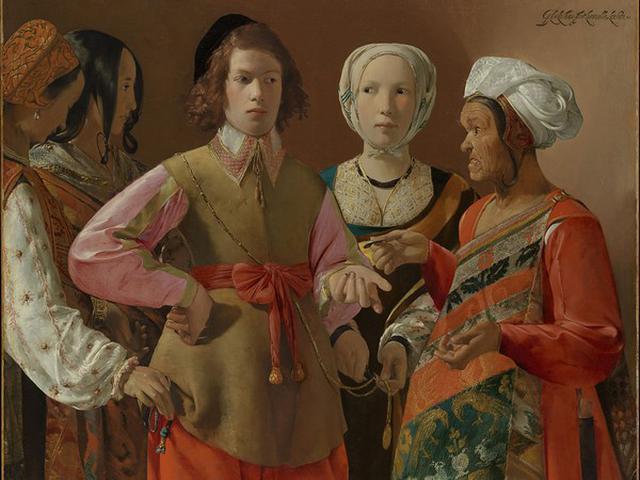The Fortune Teller (by La Tour)

The Fortune Teller by Georges de La Tour is one of the most famous French paintings of the 17th century, due to its intriguing subject matter. The Metropolitan Museum in New York has loaned this fascinating and colorful masterpiece to the Walker Art Gallery in exchange for Walker's loan of his own 17th-century French masterpiece, Nicolas Poussin's Landscape with the Ashes of Phocion.
This famous painting, which was only discovered in the mid-20th century, captures the moment when a wealthy young man, distracted by a fortune told by an old gypsy woman, is robbed by his companions. The costumes and composition may have been influenced by a theatrical scene, but such cautionary images, popularized by Caravaggio, were painted throughout Europe in the 17th century. Although scholars have debated whether the artist had seen Caravaggio's work in Rome, the inscription in the right corner includes the name of the city where the artist lived in northeastern France.
Georges de La Tour was a shadowy figure, not much is known about his life. He was born in 1593 in Vic-sur-Seille, a large commercial town in the independent duchy of Lorraine, now part of northeastern France, which was the seat of the archbishopric of Metz. His family belonged to the provincial artisan class: his father and grandfather were bakers. No documents or information about La Tour's early career survived, accounting for his conjecture of formative training. His apprenticeship probably began around 1605, perhaps in Vic with Alphonse de Rambervilliers (1560-1633), an amateur writer and engraver close to the Bishop of Metz, and most probably he worked in Nancy with the painter, engraver and draftsman Jacques Bellange (1575- 1616). The tour was recorded in Vic in 1610 and 1616, and there was much unresolved discussion about a possible trip to Rome near or between those dates.
© Tourblink